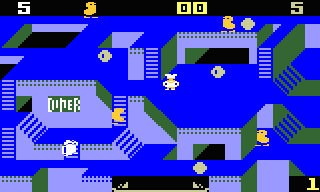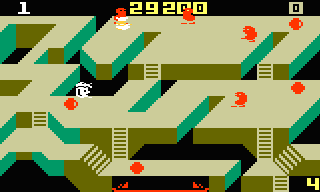 Background:
Background:
Arguably the best game ever released for the Intellivision, Diner was in fact, never supposed to exist.
When INTV Corp. bought the rights to Intellivision from Mattel Electronics in 1984, they took stock of all unreleased and incomplete games from the Mattel library.
There was a sequel to Burgertime, one of Intellivision’s most successful titles, in the works, but the game (which was to be named Pizza Time) had been developed at Mattel’s
French office, and no prototype was available.
Releasing a sequel to the wildly popular Burgertime remained a high priority however for the brain trust at INTV Corp. and while Pizza Time was no longer an option, they cast their attention to another unreleased game acquired in the takeover.
This game was to be the sequel to Masters of the Universe. Now the programmer of Masters of the Universe II was none other than Ray Kaestner, the programmer of the original Burgertime.
As John Lubbock stated above, while some may have seen a sequel to Masters of the Universe, INTV Corp. was looking for a sequel to Burgertime. With that in mind, Ray Kaestner was charged with converting Masters of the Universe II to Burgertime II. Much of the code for the original Masters of the Universe II, remained in Diner. The rest, as they say, is history. The result is in this writers opinion one of the three best titles ever released for Intellivision.
Let’s discover Diner.
 Introduction:
Introduction:
Diner continues the adventures of our favorite chef, Peter Pepper. Also returning to thwart Chef Peter are the evil Hot Dogs.
This time though, we are introduced to several new foes: a cheap Cherry, a bad Banana, and Mugsy, the Mug o’ Root Beer.
Chef Peter has graduated from his humble beginnings at the local greasy spoon serving up hamburgers, and now must contend with pushing food through the Diner to complete his lunch orders.
Chef Peter’s ace in the hole remains what else, pepper!
Gameplay:
The game involves Chef Peter trying to kick food balls down ramps and over ledges to fill plates at the bottom of the screen.
The Rotten Food of course, tries to prevent you from doing that.
You can defend yourself by kicking food balls into your enemies, squishing them, but only temporarily! After a few moments, you are pursued with renewed
vigor.
You also have a limited arsenal of pepper, which when used on your enemy, freezes them in place for several seconds. During that time you can actually run through the frozen enemies without fear of being killed.
Use your peppers wisely, you only have five to begin, but you will have a few opportunities to add more peppers, as side dishes like Sodas, and Milk Shakes, and Ice Cream appear for a few seconds in the maze. Capture these side dishes to gain a bonus of 1 pepper.
Style:
The game is essentially Congo Bongo meets Burgertime.
Presented in 3D, the presentation is reminiscent of Congo Bongo while the gameplay is vintage Burgertime.
The game offers 15 different levels, and as you progress new challenges are introduced.
Some examples are more complex mazes, featuring levels where holes open and close in the floor,
elevators which whisk Chef Peter and the Rotten Foods up and down, changing the dynamic of the pursuit instantly,
and new enemies such as the bad Banana (see above).
Another new feature in Diner is the introduction of the Bonus screen, where food balls fall from the top of the screen and Chef Peter must try to catch as many solid color balls as possible, while avoiding the flashing food balls.
The result is an entertaining, challenging and varied gaming experience with high replay value.
 Control:
Control:
The game controls beautifully. One of the few elements of Burgertime which could be criticized, was that in the 2D environment, you weren’t always able to step off a ladder and head down a platform when you wanted to.
This issue is completely resolved in Diner. In the 3D environment stepping on and off ladders is more intuitive, and result is precise control of your character.
Furthermore, with the 3D environment, you now have greater maneuverability, as it is possible to be pursued from both directions while on a platform, but still evade capture by running above or below your pursuers.
The use of pepper is controlled by the Fire Buttons, and the response time is immediate.
Changes of direction on the Disc controller result is swift, accurate movements by Chef Peter leaving you feeling in absolute control of your character.
Graphics:
The game is visually impressive, particularly considering the era in which it was released.
Chef Peter is well presented, as are the enemies, in particular Mugsy, the Mug o’ Root Beer, a graphic which is pretty unique amongst the Intellivision library and not images recycled from other titles on the system.
The lone criticism I have with respect to the graphics, is the presentation of the food balls.
In Burgertime, you knew what you were preparing, but in Diner, unless we are serving grapes, or meatballs, the food remains a mystery.
This is one small area where a little more imagination or creativity might have been more beneficial.
This small gripe is such that it is noticeable if one were to turn a critical eye to the game, but isn’t such that it will detract from your enjoyment of the game at all.
 Sound:
Sound:
One of the real successes of this game is that it contains elements which remind the player of Burgertime, as a sequel should, while not simply rehashing the same material as the predecessor.
The music is of the same up-tempo, light-hearted fare as the original, but the score is completely different.
The fact that the two could be so similar as to evoke the feelings of familiarity, while still being completely different is one of the subtle ingenuities of this game.
Sound remains a big part of the gaming experience. Critical events such as the sudden appearance of the Side Orders (rewarding the gamer with a bonus pepper), the use of your pepper, and the attempted use of your pepper when you no longer have some each carry a distinct and audible result which still fits with the background music in the game. This is some of the finest and least intrusive music you will find in any game for the Intellivision.
Overall:
The prospect of trying to follow up one of the most successful titles in the history of the Intellivision, must not have been an easy task.
The expectations were surely high, and incredibly, this game exceeds them.
This is the one game that while I love it, continues to haunt me.
When I think of this game, I am saddened to think of what might have been, had the Intellivision been allowed to continue in its development.
Too often, we are treated to a special game, only to have a developer try to cash in on the success of the original title, by releasing an inferior follow up.
This game actually improved on an acknowledged classic.
One of the real unfortunate circumstances surrounding Diner, is that due to its release in the waning years of the Intellivision, not many people were exposed to this gem. Thanks to the magic of emulation, scores of Intellivision enthusiasts will have the opportunity to enjoy this game, although playing Diner on an actual Intellivision is an experience I wish every fan of Intellivision can enjoy. I am thankful that I can.
